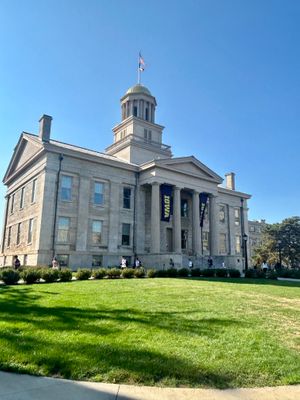The Area: Situated along the Iowa River and surrounded by rolling countryside, Iowa City is two hours from Des Moines and four hours from Chicago. Students traveling from further afield can drive 20ish minutes to Cedar Rapids and the Eastern Iowa Airport, which has direct flights to LA, Denver, Dallas, D.C., and Nashville, to name a few. But don't let the surrounding cornfields fool you–Iowa City is a bustling small city and a true college town.
The City: The campus blends directly into downtown Iowa City (pop. 76,000), and students can walk from class to coffee shops, bookstores, restaurants, and even a two-story Target within minutes. It's a compact, charming city that's easy to navigate on foot—tour guides even caution against bringing a car due to limited parking. Regularly ranked on "best college towns" lists, as well as being a designated UNESCO City of Literature, Iowa City has a vibrant literary and cultural scene (hosting numerous festivals and performances year-round) and the energy of a university hub.
The Campus/Students: Bounded clearly by the Iowa River and downtown, Iowa's attractive campus is very accessible—you can walk across it in about 10 minutes. Buildings are a mix of Greek Revival the state's original capital building is a centerpiece on campus) and modern. Housing varies from new and "hotel-like" to older and more traditional; students have 20+ living-learning community housing options to choose from, as well.
With 23,000 undergrads (31,452 total students), Iowa is a Big Ten university that feels manageable. Athletic culture is spirited, especially on football Saturdays in Kinnick Stadium, when 70,000 enthusiastic Hawkeye fans and players rise to wave to patients at the nearby children's hospital. Wrestling is nationally ranked (with a women's team recently added), and women's and men's basketball have had strong seasons in recent years. Club and intramural athletics are strong, and more than 500 student organizations provide plenty of opportunities for sporty and non-sporty students alike. Greek life exists, but is not dominant, with about 30% of students participating. With a vibrant downtown bordering campus, students (described as friendly and welcoming), find plenty of ways to get involved both on and off campus.
The student body is about 20% students of color, and students come from all over the U.S. (about 50% in- and out-of-state) and the world.
Academics:
Unlike many flagship colleges where some majors are nearly impossible to get into, students at Iowa can find multiple pathways to study what they want–whether it's business, engineering, the sciences, or creative writing. While direct-entry pathways exist, students who may not qualify upon admission can move into competitive majors later. It's also easy for students to change their major, pick up minors, or even come in undecided—students aren't locked into a track and have the flexibility to explore. Freshman classes are generally large, but half of all classes on campus have fewer than 20 students. Professors are generally described as accessible, and the school has a Four-Year Graduation Plan that guarantees students an on-track path to a diploma.
Notable Programs/Admissions Notes:
- The English and Creative Writing major, consistently ranked among the best in the nation, welcomes students without requiring a portfolio. The famed Iowa Writers' Workshop, a graduate-level MFA program, has earned global prestige, and the university offers related paths like Journalism, Screenwriting, and the Young Writers Studio, a selective summer experience for high schoolers. (Iowa City is a designated UNESCO City of Literature.)
- The Tippie College of Business is highly ranked, with a transparent and accessible path for direct admission (pre-calc recommended). Students can also transfer in later by meeting clear academic benchmarks.
- Iowa is also home to strong pre-health advising, excellent pathways in nursing, pharmacy, PT, and exercise science, and one of the largest teaching hospitals in the U.S. within walking distance of campus.
- The College of Nursing offers 80 direct admit spots each year (due Nov 1, with physics required) and another 80 through a competitive pathway.
- The College of Pharmacy has a new building and an assured admission option for qualified high schoolers.
- Iowa's Physician Assistant (P.A.) program ranks #2 nationally.
- In engineering, direct admission requires at least pre-calculus, but students can still find their way to an engineering degree through a pre-engineering track.
- Iowa's Office of Undergraduate Research (OUR) helps students across all majors get involved in research early. With four hospitals within a 20-minute walk and robust support services, students have unmatched access to real-world learning, especially in health and science fields.
Cost: As of 2024–25, the total cost of attendance (including tuition, room & board, fees, and travel) is approximately $28,000 for Iowa residents and $50,000 for non-residents. Merit scholarships are widely available, especially for out-of-state students, and the Iowa Scholarship Portal helps connect students to additional opportunities.
The University of Iowa offers the best of both worlds: a Big Ten experience in a cozy, walkable, and arts-rich college town. With exceptional programs in writing, business, health sciences, and more and a supportive atmosphere that makes it easy to explore majors, Iowa stands out as a flexible, welcoming, and opportunity-rich public university—one where the sciences and the arts are equally valued.
Visit the University of Iowa's website to learn more and see if it's a good fit for you.

